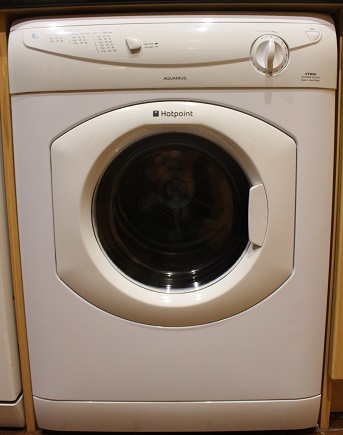Strange noises from machines play on my mind. None more so than when that niggling noise starts to get worse. Noises like that usually mean two things. Catastrophic failure and expense.
Time to disconnect from the mains and fetch the tool box.
The patient in the surgery this week is our own Hotpoint tumble dryer. We avoid using it at all costs, but with miserable English weather and two children, getting washing turned around efficiently, ready for use is mandatory. To be frank, I’d noticed the excess whinning bearing noise coming from the dryer for a few uses, but it was getting to the point where it was hard to ignore.
Electric hot air tumble dryers are pretty simple things. They work by sucking cool air in, heating it up under thermostatic control and then blowing it in to a rotating drum. The moist air is then expelled via a filter and then hose, to atmosphere. Tumble dryer models of this kind will have the following: A motor, heater, thermostat circuitry, timer and a drum. There isn’t much to go wrong and many parts for UK tumble dryers are available, cheaply from places like eSpares.co.uk. Usually, no special tools are required if you want to have a go at fixing your machine and I recommend you do of course.

After opening up the cabinet, access to the drum and motor was available by the side panel which was held in position with several self-tapping screws and hooks. Care must be taken if you attempt something similar on your machine since there are plenty of sharp edges to watch out for. This dryer features an AC induction motor (which has no motor brushes). It has a spindle which runs through the motor with a pully one side to drive the drum via the belt and a fan the other to blow the hot air. Removing the belt and spinning the motor by hand revealed the problem. The spindle spun OK, but sounded rough.
Replacement motors are available at a reasonable £90 or so, but you know me by now, I don’t like spending that kind of money, unless I have to.
The motor is attached to the appliance with simple bolts and is removed easily. The motor is held together with self-tapping screws, which are easily accessible. Just two bearings feature in this motor; one at each end to support the load. Both bearings sounded rough, but seemed not to be worn too much. The bearings are standard items and it would be easy to find exact replacements from a bearing supplier (rather than replacing the whole motor), for under £20. However, as this was my own machine, I went for cheaper fix, to squeeze more life out of what I already had. With the dust cover popped off from both bearings, I cleaned both with isopropyl alcohol cleaner and then re-greased with quality high-melt point bearing grease. Much better.
The motor re-assembled, re-installed back in the machine and it was time to switch on. It now sounded as sweat as a nut.
If and when the bearings get noisy again (and they will eventually), I’ll replace the bearings with new ones.
Cost of replacement: circa £200. Cost of repair: My time, two cups of tea, one custard cream, a bit of grease. Not in that order.


